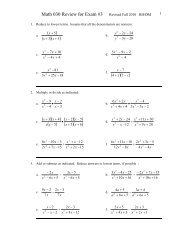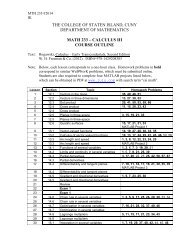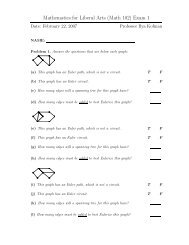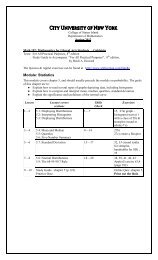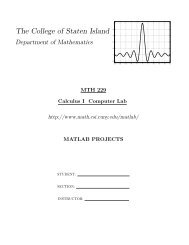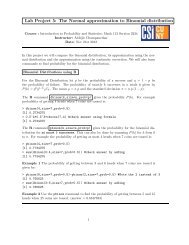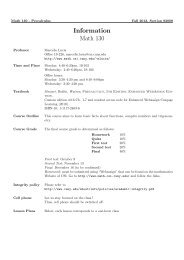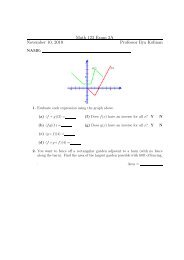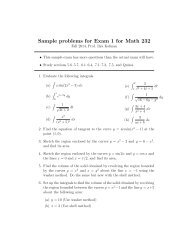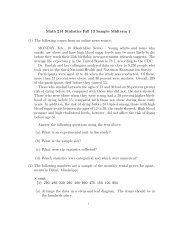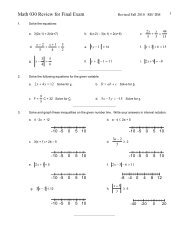Math 229 Sample Final Exam
Math 229 Sample Final Exam
Math 229 Sample Final Exam
- No tags were found...
You also want an ePaper? Increase the reach of your titles
YUMPU automatically turns print PDFs into web optimized ePapers that Google loves.
<strong>Math</strong> <strong>229</strong> <strong>Sample</strong> <strong>Final</strong> <strong>Exam</strong>Date: December 7, 2009Professor Ilya KofmanNAME:Problem 1. (10pts.)f(x) = cos(πx) + sin( πx)3andg(x) = sin(πx)x(a) Circle True or False: f(x) is periodic. T FCircle True or False: g(x) is periodic. T FDetermine the length(s) of the period for any function that is periodic.(b) For 3 ≤ x ≤ 4, for which x does f(x) = g(x)? (accurate to 3 decimal places)Problem 2. (10pts.)Use MATLAB to find all x (to two decimal places) where6 sin (5x) = −14x − 15Give the answer, and write the MATLAB commands used to get your answer.
Problem 3. (10pts.) Let f(x) = 2x 4 − 13x 2 − 30.(a) Write the commands to compute the roots of f(x) using the roots function inMATLAB.(b) How many roots are listed as the output of the roots function?(c) What are the real root(s) (accurate to 4 decimal places)?Problem 4. (10pts.)()1Find the minimum (to 3 decimal places) of f(x) = cos(x) +on (0, π).(x − π) 4Write the MATLAB commands you used to get your answer.
Problem 5. (20pts.)Let f(x) = x √ ( 23 sin .x)(a) Write the m-file for the function f(x).(b) Compute f(π) to 10 decimal places.(c) Compute limx→0f(x) to 4 decimal places.(d) Computelim f(x) to 4 decimal places.x→∞(e) For 0 < x < 1, how many relative maxima/minima does f(x) have? Explain.
Problem 6. (20pts.)Let f(x) = e x/2 cos(x).(a) Write the m-file for the function f(x).(b) Plot f(x) and its approximate derivative with h = 0.001, for 0 ≤ x ≤ 2π.Find the x-coordinates of the following points (accurate to 2 decimal places):(i) Points where f(x) = 0:(ii) Points where f ′ (x) = 0:(iii) Points where f ′′ (x) = 0 (Recall, f ′′ (x) is the first derivative of f ′ (x)):(iv) Points where f(x) = f ′ (x):
Problem 7. (10pts.)Suppose we know the derivative g ′ (x) = x 2 + cos(πx).(a) Graph g ′ (x) for various ranges of x. For which x is g ′ (x) = 0 ?(b) Identify critical points from part (a) for x > 0 as relative maxima/minima ofg(x). Apply the first derivative test: How does the graph cross the x–axis?Problem 8. (10pts.) Let f(x) = e x −x 6 . Starting at x = 1, apply Newton’s methodto find where f(x) = 0 to four decimal places. Show work.x n+1 = x n − f(x n)f ′ (x n )
Problem 9. (20pts.)to the point Q(4, 1).Find the point P (x, y) on the parabola y = 1 2 x2 that is closest(a) What is the function d(x, y) that gives the distance from P (x, y) on the parabolato Q(4, 1)?(b) Write the m-file for the function d(x) that gives the distance from P (x, y) onthe parabola to Q(4, 1).(c) Compute d ′ (x) using difquo with h = 0.001. Using d(x) from part (b), whatis difquo?(d) Plot difquo for 0 ≤ x ≤ 4. For which x is d ′ (x) = 0? What is P (x, y)?(e) Why is this x–value a minimum for d(x)? Apply the first derivative test: Howdoes the graph cross the x–axis?



